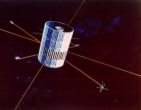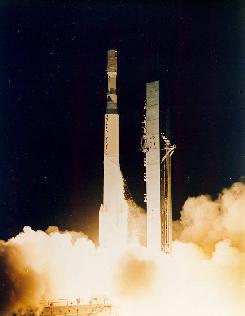FLUXGATE MAGNETOMETER
The sensitivity is controlled by the negative feedback, and the desired range is obtained by changing the feedback elements. The operating range is determined by 2 binary bits generated by two relays. The range is selected by range change commands generated in the Magnetometer Processor; 4 command lines are required.
MAGNETOMETER PROCESSOR
The magnetometer processor in the magnetic field experiment does the following:- Analog to Digital conversion of the magnetic field signals.
- Digital filtering of the magnetic field signals.
- Delta modulation of the magnetic field signals. (This data stream was not used on-ground.)
- Data multiplexing of the two processing systems,(one redundant), high and low bit rate data, and the combining of the absolute value words and delta modulation 2-bit words into a serial output bit stream.
- Interfacing with the spacecraft data encoder.
- Interfacing with the spacecraft for commands.
- Automatic range switching, sensing, control and range relay drive.
- Sensitivity calibration control and signal generation.
- Mechanical flipper control and drive.
- Monitoring of the engineering status.
ANALOG TO DIGITAL CONVERTERS
Sampling of the data is done every forty milliseconds in synchronism with an encoder furnished signal. The data is stored in a sample-and-hold circuit until the internal timing of the magnetometer processor is ready to commence its sample cycle. All three axes are sampled simultaneously.The analog to digital conversion is done by a double ramp (RC charge-discharge) A/D converter. The converter works by charging the RC circuit with the voltage to be measured during a precise time period, discharging the circuit into a negative reference voltage, and then measuring the discharge time with a crystal controlled clock. Most component induced errors are canceled out due to charge and discharge of the same RC components.
There are three sample-and-hold circuits and three A/D converters (one per axis) per system. For the total of two systems there are six sample-and-hold circuits and A/D converters. The three A/D converters per system have been used to provide redundancy so that the system is not lost in the case of a single converter failure.
SYSTEM REDUNDANCY
Redundancy has been built into the processor and encoder to circumvent failures and/or minimize their impact. There are two main data handling systems(A or B) in the processor. Each system has a digital filter, a delta modulator, range sensing logic, and sets of A/D converters. A double set of encoders has also been provided in the spacecraft, and either of the processor systems can work with either of the two encoder systems,so that proper operation can occur with any combination of failures of one processor system and/or one encoder system. Three A/D converters per system have been provided, for a total of 6 in the processor, in order to reduce the data loss if one A/D converter is lost.
OUTPUT MULTIPLEXER
The output multiplexer performs three basic functions:- Mixing of the X,Y and Z absolute data words and delta modulation 2-bit words into a serial bit stream.
- Selection of system A or system B data.
- Selecting the proper number of samples for high and low bit rates.
TIMING
There are three timing standards for the experiment. Two are derived from crystal controlled clocks and the other is derived from the encoder timing signals. There are two separate and identical crystal controlled timing units, one per system (A or B). The experiment sampling is done in synchronism with a 40 millisecond encoder signal. The internal data processing within the experiment is done in synchronism with the crystal clocks.Because the memory for the digital filter is dynamic, it is kept running all of the time. After sampling is done and the data stored in a sample-and hold circuit, processing and A/D conversion of the data are held up until the MOS memory is in the proper position with respect to the processing timing. The data processing sequence is divided into 8 equal time periods and one variable time period. Period 0 is the variable time period between the time when the sample-and-hold takes the data and the time that the MOS memory is in its desired starting state. During periods 1 and 2 the previous sample of X-axis data is processed in the digital filter. In time period 2 the A/D charge takes place. The A/D discharge (for all axes) takes place during time periods 3,4,5 and 6. In time period 3 the X-axis data which has been processed by the digital filter is processed by the delta modulator. During time periods 3 and 4 the Y-axis data is processed by the digital filter; this data is also from the previous sample time. In period 5 the filtered Y-axis data is processed in the delta modulator. In time period 7 the Z-axis data from the previous sample is processed by the delta modulator. In time period 8 of every eighth sample period the Z-axis is separately processed for both high and low bit rates.
Return to IMP-8 Home Page.
Page last modified June 14, 2001

